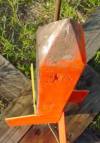 |
5-14-02a 28mm aluminum engine cast nozzle 3-grain Bates configuration |
Foundry
Micro Mini Midi Dimples Flight Test How To... Home |
 |
5-14-02a 28mm aluminum engine cast nozzle 3-grain Bates configuration |
Foundry
Micro Mini Midi Dimples Flight Test How To... Home |
"Kurt" was my first 4x4 airframe. It flew well three times, but was disabled by CATO on Christmas Day 2001.
The remnants sat around for awhile. Then I realized a need for a slightly lighter airframe for use with these aluminum engines, somewhat smaller than the PVC engines for which the original 4x4 was designed. So I cut off what was left of the engine bay, glued the splinters back together, and made a shorter version. With a new set of dorky fins and a really odd paint-job, "Kurt" is ready to fly again. He is about three pounds lighter, good for testing these "Low-G" class engines.
The funny green thing is a foam ear-plug. I find these to be really
good nozzle sealers. Notice in the second photo how the nozzle protrudes
a bit from its tubing. This nozzle was a bit loose after casting.
I tried to drive it out with a rod and hammer and that was as far as it
would go. I static-tested it with a full charge - it stayed put.
So I figure it has found its spot
Calculated thrust curve is asymmetrical because the grains are a bit longer than the ideal Bates dimension for this diameter.
Note that the nozzle has shifted forward. This is unexpected. Apparently, the inertia of a sudden stop is significant. I also suspect that the thin aluminum tube heats more quickly than the massive aluminum nozzle, thus expanding a bit and loosening the nozzle. I have sometimes drilled and tapped small holes in the nozzle region and inserted small setscrews to lock the nozzle in place. This worked OK, but then I found a better way.
Details: Spreadsheet output:
| LumberCalc | Version 1d | Data for flight 5-14-02a | "Kurt" - 7-poundish 4x4 | |||
| Measured: | Calculated: | |||||
| Distance * | Feet | Meters | Rise/Run at apogee: | 0.653529 | < ratio of height on pole at apogee / distance to pole | |
| A. Camera to measuring pole | 5.1 | 1.554404 | Rise/Run at burnout: | 0.211765 | < height on pole at burnout / distance to pole | |
| B. Camera to launcher | 280 | 85.33984 | ||||
| C. Camera to touchdown | 231 | 70.40536 | Height at apogee: | 50.89203 | < distance to apogee * rise/run ratio at apogee | |
| D. Launcher to touchdown | 59 | 17.98232 | Height at burnout: | 18.07197 | < distance to burnout * rise/run ratio at burnout | |
| E. Rise on pole at burnout | 1.08 | 0.329168 | Rise height after burnout: | 32.82007 | < height at apogee - height at burnout | |
| F. Rise on pole at apogee | 3.333 | 1.015849 | ||||
| * Letters A-F refer to drawing on Sheet 2 | Rise time, burnout to apogee: | 2.588044 | < calculated from rise height, deceleration by gravity | |||
| Time, launch to apogee | 3.348044 | < boost time + rise time | ||||
| Time | Seconds | Fall time, apogee to ground | 3.222752 | < calculated from height at apogee & gravity | ||
| Thrust duration | 0.76 | Total Flight time (calculated) | 6.570796 | < calculated boost + rise + fall time) | ||
| Descent from apogee | 3.3 | %Error between flight times: | 0.016201 | < comparing measured vs. calculated times | ||
| Total flight time (measured) | 6.679 | |||||
| Velocity at burnout (m/sec) | 25.36283 | < calculated from rise height, deceleration by gravity | ||||
| Weight | Kilograms | Acceleration, actual (m/s^2) | 33.37215 | < velocity at burnout / thrust duration | ||
| Fuel charge | 0.1007 | Acceleration, felt (m/s^2) | 43.17215 | < actual acceleration + gravity | ||
| Total launch weight | 3.2925 | Thrust (Newtons) | 142.1443 | < felt acceleration * total weight | ||
| Total Impulse (N-Sec) | 108.0297 | < thrust * thrust duration | ||||
| Isp (N-Sec/kg) | 1072.787 | < total impulse / mass of fuel charge | ||||
| Jimmy Yawn | Seconds | 109.4681 | < Isp / gravity | |||
| jyawn@sfcc.net | ||||||
| 5/14/02 | Height (of doubtful accuracy) | 53.361 | < calculated from measured fall time |
Click here to download a copy of this spreadsheet, Excel format
Graph of wavefile extracted from video:

Events:
0.6 seconds, Ignition switch clicks
1.45 seconds, Thrust begins*
2.2 seconds, burnout (tapering-off noise is echo)
8.4 seconds, vehicle hits ground
*The ignition switch is right by the camera and the launcher is 280 feet away. Thus the ignition delay is about 1/4 second less than the .wav file would suggest.
JY
5/15/02